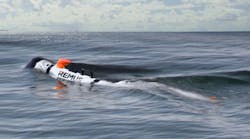Sypris Data Systems issued patent for network technology
Officials at the U.S. Patent & Trademark Office recently issued U.S. Patent 6,892,167 to Sypris Data Systems Inc., in San Dimas, Calif., for the company’s real-time data-acquisition network technology. The technology incorporates real-time storage-area network architecture capable of high individual and aggregate bandwidths, many input/output channels, different data types and formats, and expandable storage capacities. The architecture uses a switched-fibre-channel network for high-speed, multiple, simultaneous data transfers. The network technology is flexible, modular, and designed to record real-time data from receivers of SIGINT signals, telecom signals, satellite-link telemetry signals, imagery data, and other wideband data. For more information visit www.syprisdatasystems.com
CableTest serves Belgian F-16 upgrade
CableTest Systems Inc., in Markham, Ontario, recently announced that its MPT wiring and interconnect test system will be used by the Belgian military as its next-generation test platform for F-16 Mid-Life Upgrade (MLU). The MPT will enable the use of legacy test programs as well as future expansion beyond depot-level testing to incorporate other tests such as functional and environmental stress screening, CableTest officials say.
Key features of the test system will include legacy test program conversion utilities, multiple-source selection and switching capability from within the MPT program environment, and adaptation technology for simplifying the interconnect process and minimizing maintenance. The MPT system’s modular approach to hardware and software architecture will protect the test platform from obsolescence by allowing the addition of third-party external devices as evolving requirements demand new test methods, company officials say.
Northrop Grumman system wins coalition award
A system developed by Northrop Grumman Mission Systems that provides joint coalition forces with a clear, continuous common operating picture of the battlefield in Iraq and Afghanistan has been honored as the “Best Program in Support of Coalition Operations.” The Force XXI Battle Command Brigade and Below (FBCB2)-Blue Force Tracking system and its Coalition Force Tracker variant received the award at the Battlespace Information 2005 conference in London earlier this year. FBCB2-Blue Force Tracking and Coalition Force Tracker are systems of ruggedized computer hardware and software that form a wireless “tactical Internet” on the battlefield, linking satellites, sensors, communications devices, vehicles, aircraft and weapons in a seamless, secure digital network. Coalition Force Tracker is interoperable with U.S. systems while complying with U.S. security measures. Northrop Grumman’s Mission Systems sector, based in Reston, Va., is the prime contractor for FBCB2-Blue Force Tracking and Coalition Force Tracker.
Northrop Grumman delivers test equipment for JSF engine
Officials at Northrop Grumman Integrated Systems in El Segundo, Calif., delivered four pieces of test equipment to Pratt & Whitney that will enable the aircraft-engine manufacturer to test key subsystems with the new propulsion system it is developing for the F-35 Joint Strike Fighter. The four electrical power system test consoles will enable Pratt & Whitney to test the main engine’s unique, combined starter/generator. Unlike other aircraft, which typically use a separate pneumatic or gas turbine starter, the F-35 incorporates “start” capabilities within its main generator. This approach creates a more efficient design and reduces the aircraft’s weight, Northrop Grumman officials say. Northrop Grumman is also developing the signal-and-control harnesses used to connect the consoles to the electrical power system on the test engines.
Curtiss-Wright Controls to deliver subsystems for TERRIER Combat Engineer Tractor
Officials at BAE Systems in England recently contracted Curtiss-Wright Controls (CWC) in Santa Clarita, Calif., for the development and production of Drive-By-Wire (DBW) and the Special-To-Role (STR) controller subsystems for the United Kingdom armed forces’ next-generation TERRIER Combat Engineer Tractor. Curtiss-Wright Controls (CWC) and BAE Systems Land Systems have been collaborating over the past year to develop the hardware for the two controllers. CWC will produce the DBW subsystem that provides data management, power control, and video switching for the TERRIER’s on-board driving and surveillance cameras and remote control functionality. CWC will also manufacture the STR subsystem that provides processor control for the on-board hydraulic systems and valve drives that manage the combat vehicle’s heavy-duty equipment, including dozer blade shovel, side scoop, and jack hammer. For more information visit www.cwcontrols.com.
DRS Technologies acquires Codem Systems
Officials at DRS Technologies, in Parsippany, N.J., recently announced that DRS has acquired Codem Systems Inc. in a stock purchase transaction valued at approximately $29 million in cash, with additional consideration payable upon achievement of certain financial targets. Codem Systems is a privately held business located in Merrimack, N.H. It is a provider of signals intelligence (SIGINT) systems, network-interface modules, and high-performance antenna-control systems. Codem focuses on solutions for communications and surveillance applications supporting the intelligence, military, and homeland security markets. The company’s expertise is concentrated in systems engineering software and hardware development as well as end-user training. “Codem enhances DRS’s position in intelligence and surveillance systems, while supporting greater access to emerging market opportunities, such as those related to homeland defense,” says Mark S. Newman, chairman, president, and chief executive officer of DRS Technologies. For more information visit www.drs.com.
BAE computer supports Air Force experimental satellite
The RAD750 single-board computer, built at BAE Systems’ Manassas, Va., is supporting the Air Force Research Laboratory’s Experimental Satellite System-11 (XSS-11) spacecraft. The mission was launched from Vandenberg Air Force Base, Calif., on April 11, boosting the satellite into Earth orbit. The RAD750 is the backbone of the spacecraft’s command and data handling system, designed by Broad Reach Engineering Co. in Golden, Colo., BAE Systems officials say. “The RAD750 will provide the necessary computing power in the command and data-handling subsystem of the spacecraft, which enables control and telemetry in flying the XSS-11,” says Tom Bowmaster, BAE Systems’ program manager. The mission will last 12 to 18 months. The XSS-11 will demonstrate new autonomous satellite features.


